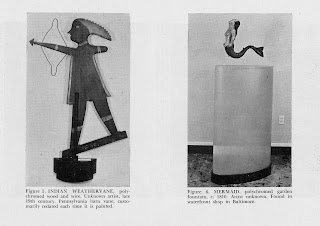I found this 1950s matchbook cover on eBay recently and it reminded me of the old folk art galleries at the Fenimore Art Museum. Prior to the late 1990s, I should say, we were actually known as Fenimore House, as real misnomer for alot of reasons. Scores of visitors came to our door convinced they were about to experience James Fenimore Cooper's home, which we were not. Their disappointment was palpable, but usually molified by the great collections that we did have for them to see.
Primary among those collections, of course, was our American folk art. When I first came to Cooperstown in the early 1980s, the folk art collection was displayed in a series of small rooms on the second floor. But back in the 1950s, the collection could only be accessed by descending a staircase to your immediate left near the front door. The stairs led down one flight to three small rooms with one long, open space in the rear.
When Fenimore House was a private mansion in the late 1930s, these rooms had a variety of functions ranging from wine cellar to carpenter's shop to (yes, it's true) indoor swimming pool. These spaces were gradually renovated in the late 1940s as the folk art collection grew, culminating with the grand acquisition of the Lipman collection in 1950. The resulting galleries received national attention with a cover story in "Art In America" that included a profusely illustrated article about the collection and its new home.
The exhibit design was done by Janet MacFarlane, the curator at the time and a remarkably capable professional who also had a large role in the development of The Farmers' Museum, our sister instittution across the road. Working within constraints that are much more noticeable to our eyes today than they were then -- the low ceilings and flourescent lighting come to mind -- I think that she created an installation that is really quite compelling. I can at least sympathize with Ms. MacFarlane, since my first folk art exhibition at Fenimore House was mounted in these same galleries. Not much had changed between 1950 and 1983.
Now, thank goodness, these spaces are gone. They were gutted during the construction of the 18,000-square-foot addition to the Fenimore Art Museum in 1995, built to house the Thaw Collection of American Indian Art along with changing exhibitions that, over the years, have included many folk art shows. But these old images, and that old matchbook, always remind me of a time when folk art was a fresh, new experience and an exciting addition to the knowledge and awareness of the American past. It's a worthy yardstick against which to measure any new installation of this great collection.
















I have a painting of George Washington which was purchased in Greene County,NY that looks like the work of Maryann Willson, however it is painted on glass. Was she ever known to paint on glass? It was purchased at a barn sale.
ReplyDelete